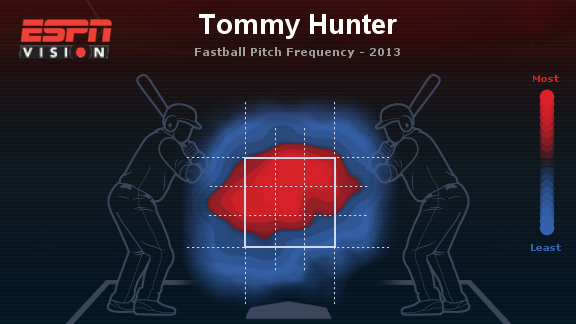So far, Tommy Hunter’s first season as the Baltimore
Orioles’ closer has been pretty successful.
He’s been throwing straight up gas (average FB clocked just under 96
mph) and converted 7 of his 8 save opportunities. The fact that Jim Johnson has not only
struggled in Oakland, but has been removed as the team’s closer already,
probably reinforces the idea that trading Johnson and giving Hunter the
closer’s job was a good idea this offseason.
However, when Hunter has pitched this season, there’s been
no shortage of excitement. So far he has pitched in 9 innings over the course of 10 games. In those 10 games, he has faced more than the
minimum number of hitters in all but 3 of them.
Furthermore, each of those 3 games where he faced the minimum number of
hitters was during an outing that lasted less than an inning. Overall, he’s facing on average almost 4.25
batters per inning pitched.
Some of these baserunners may be the result of some early
season bad luck, as Hunter’s BABIP currently sits at .357. However, the fact that many of these runners
have failed to score once they reach base may be due to some good luck, since
Hunter has a LOB% of 86.2%, well above the 2013 league average of 75.2% (for
relief pitchers only). Since it’s so
early in the season, the fact that both of these statistics have a good chance
of regressing to the mean, may actually lead to no significant change at all in Hunter’s
overall performance.
But if Hunter continues to allow batters to reach base, the
way he pitches should make for some additional stress filled moments during
close games in the 9th inning.
Ok, so the above GIF is a slight exaggeration. But the truth is that Hunter has a tendency
to pitch up in the zone. See for
yourself…
This probably isn’t a small sample size phenomenon for 2014
either, as it appears to be the way he went after hitters last year as well,
when he was used exclusively as a reliever for the first time in his career.
With the frequency that Hunter pitches up in the zone, it’s
surprising that he gets as many groundballs as he does. He’s still primarily a flyball pitcher, but I
would have thought his batted ball profile would have been a little more
extreme. This may be due to the fact
though that his fastball is good enough to overpower mediocre hitters when
thrown up in the zone.
Tommy Hunter may have proven himself to have the “ability”
to close games so far this season, but he is essentially the same pitcher he’s
always been. This isn’t necessarily a
bad thing, as he’s shown to be a dependable reliever in the right
situations. Now that he’s established
himself as the closer though, he may find himself pitching in the 9th
inning of a close game facing a left handed hitter who can handle a fastball up
in the zone more than he should. This doesn’t
mean he won’t be successful, but it should definitely keep Baltimore fans on
the edge of their seats all summer long.
(****Note: the statistics used in this article did not include Hunter's appearance in the second game of the May 1 double-header, where he retired the only two batters he faced)
(****Note: the statistics used in this article did not include Hunter's appearance in the second game of the May 1 double-header, where he retired the only two batters he faced)



3 comments:
As long as he maintains his 5:1 K:BB ratio, he'll be a serviceable closer. But fly ball pitchers like him give up way too many HR to be a dominant closer unless he can get his K rate into the Kenley Jansen range...
Is this a result of mechanics (Hunter can't get over the top of the ball), velocity (do guys who throw that hard naturally throw up in the zone) or game calling (does Wieters not call for low fastballs)? I honestly don't know and would be intrigued to find out.
Four steamers are typically thrown high in the strike zone. Batters tend to swing under, missing or hitting a popup. You will see most swing and misses up high in the zone with this pitch.
Post a Comment